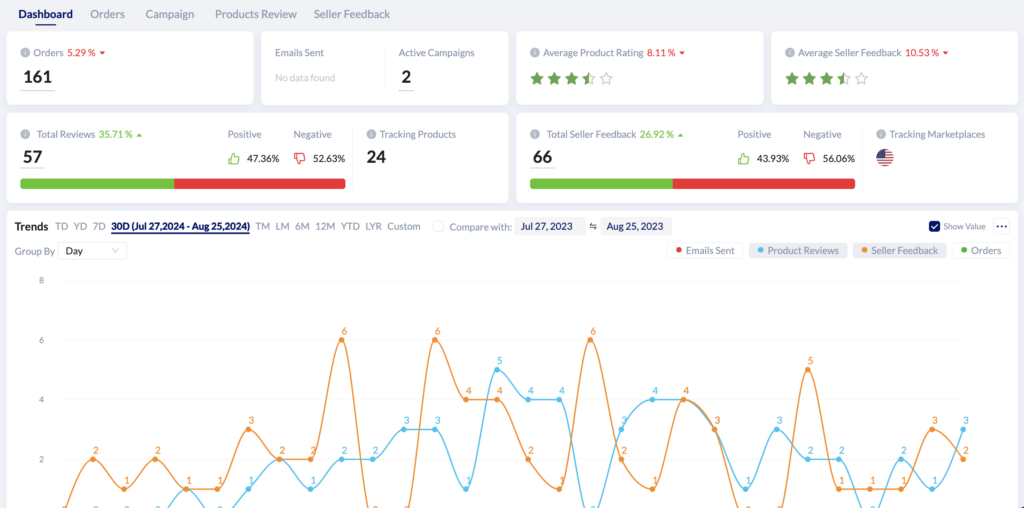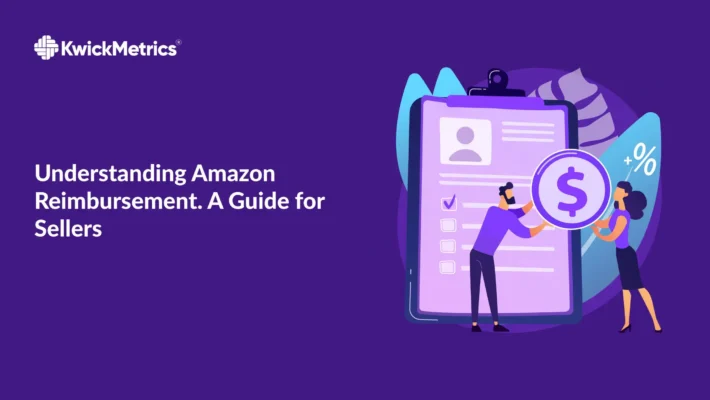KwickMetrics: A Walmart-Focused Alternative for Sellerboard

Table of Contents
If you’re reading this, you’re likely a seller looking to streamline and optimize your Walmart business. Perhaps you’re frustrated by the time it takes to track profits, manage inventory, or predict future sales trends. Maybe you’ve been using a platform like Sellerboard but feel limited by its Amazon-only focus and are curious if there’s a better solution for managing both Amazon and Walmart sales.
At KwickMetrics, we’ve been asked countless times how we stack up against Sellerboard. As both platforms offer powerful tools for its sellers, it’s a common comparison—and an important one, especially if you’re selling on more than just Amazon. Our team understands that choosing the right tool can significantly impact the efficiency and success of your business, so we wanted to offer a transparent analysis of the tool that supports Walmart Sellers.
By the end of this article, you’ll have a clear understanding of how KwickMetrics and Sellerboard compare across key features, including sales tracking, inventory management, reporting, and more. You’ll also be equipped to make an informed decision based on your business’s unique needs, especially if you’re seeking a solution that caters to both Amazon and Walmart platforms.
Discover How KwickMetrics Can Transform Your Walmart Selling Experience!
No credit card required.
How KwickMetrics is different from Sellerboard?
Unlike Sellerboard, which only supports Amazon, KwickMetrics offers advanced analytics and profit tracking for both Amazon and Walmart sellers, giving you the flexibility to manage your business across multiple channels. In this article, we will explore how KwickMetrics serves as an alternative to Sellerboard, highlighting the features that make it the alternative for sellers looking to optimize their multi-channel business operations in one single platform.
In today’s competitive e-commerce landscape, sellers need tools that offer more than just basic analytics. From multi-marketplace integration to innovative features, KwickMetrics offers a flexible, scalable, and user-friendly platform designed to help sellers thrive across various channels. Below, we explore the key areas where KwickMetrics distinguishes itself as a superior alternative to Sellerboard.
1. Multi-Marketplace Integration:
KwickMetrics provides seamless integration for both Amazon and Walmart, allowing you to manage your business across multiple platforms from a single dashboard. While sellers using Sellerboard for their Amazon business often seek alternatives for managing their Walmart accounts – since Sellerboard does not support Walmart – KwickMetrics steps in to fill that gap. KwickMetrics supports multi-channel operations currently supporting all Amazon marketplaces and Walmart US marketplace and is positioned for future integrations with additional marketplaces, making it a versatile solution for expanding e-commerce businesses.


2. Profit and Loss Tracking:
KwickMetrics provides detailed P&L tracking designed specifically for Walmart sellers, offering a clear understanding of your business’s true profitability. Walmart sellers can benefit from precise profit calculations by factoring in various fees and charges, such as shipping tax, item tax, item price, and shipping costs. Key fees like commissions, Walmart Fulfillment Services (WFS) fees, and return shipping fees are automatically accounted for, giving you an accurate representation of your net profits.
KwickMetrics excels by offering flexible P&L tracking at different levels, allowing you to observe profitability from a broad account overview down to granular details for individual products. Each of these views provides sellers with unique insights, enabling them to make more informed decisions and optimize their operations at various levels. This comprehensive reporting allows you to extract complete product details, saving you valuable time. These levels include:
- Account Level
- Order Level
- Product Level & Multiple Products Level
- Category Level (Custom Grouping)
- SKU Level
A sample report for each type mentioned above is provided below for your reference.
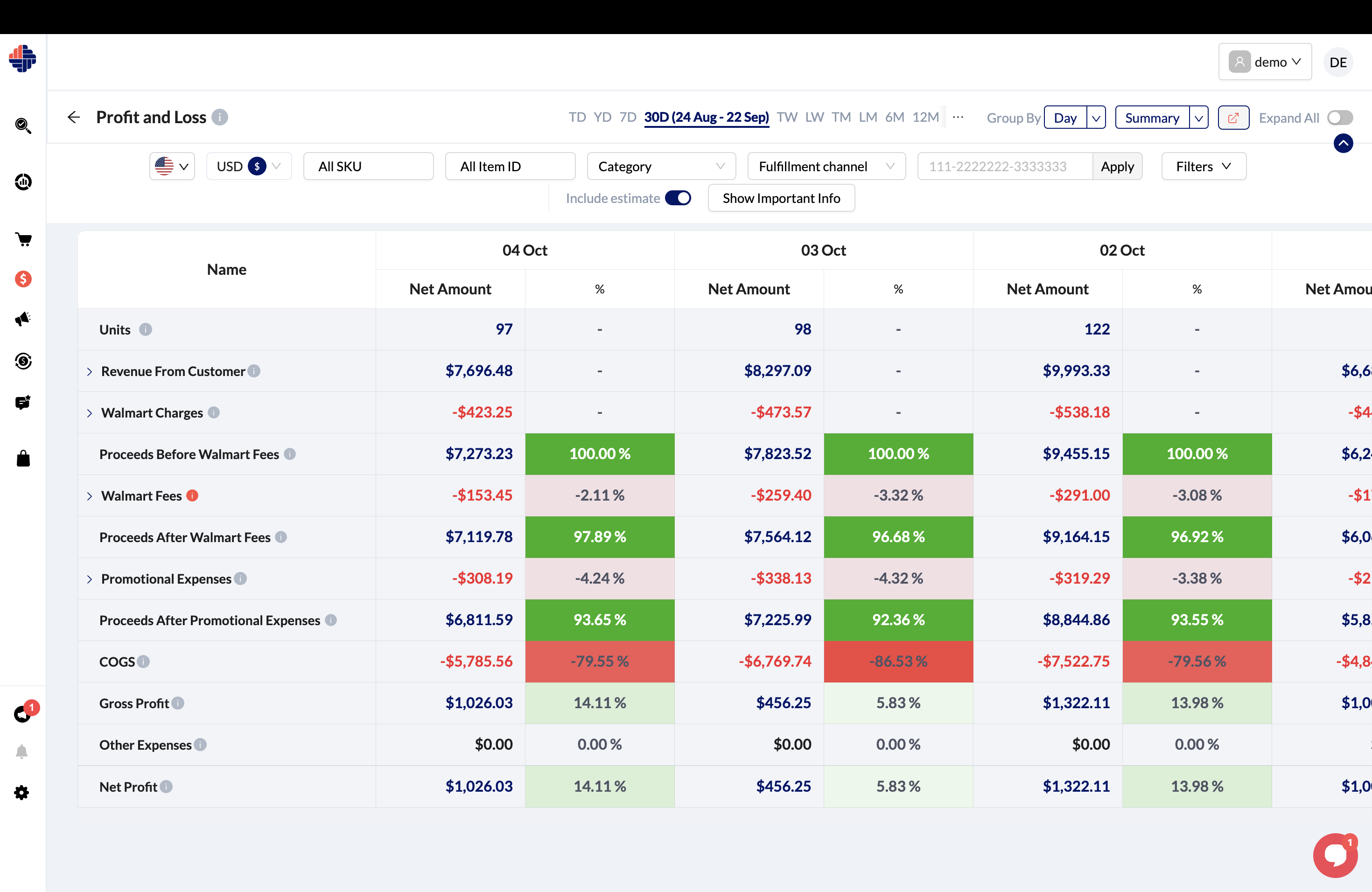
Account Level P & L
The Account Level P&L provides a comprehensive, top-level view of your entire Walmart store’s financial performance. It aggregates data across all orders, products, and categories, giving you a holistic understanding of your overall profitability over a specific time period.
Sellers can quickly assess the overall health of their business by viewing total revenues, expenses, and net profit. By reviewing high-level data, sellers can identify any potential issues, such as rising expenses, and take immediate action to optimize operations.
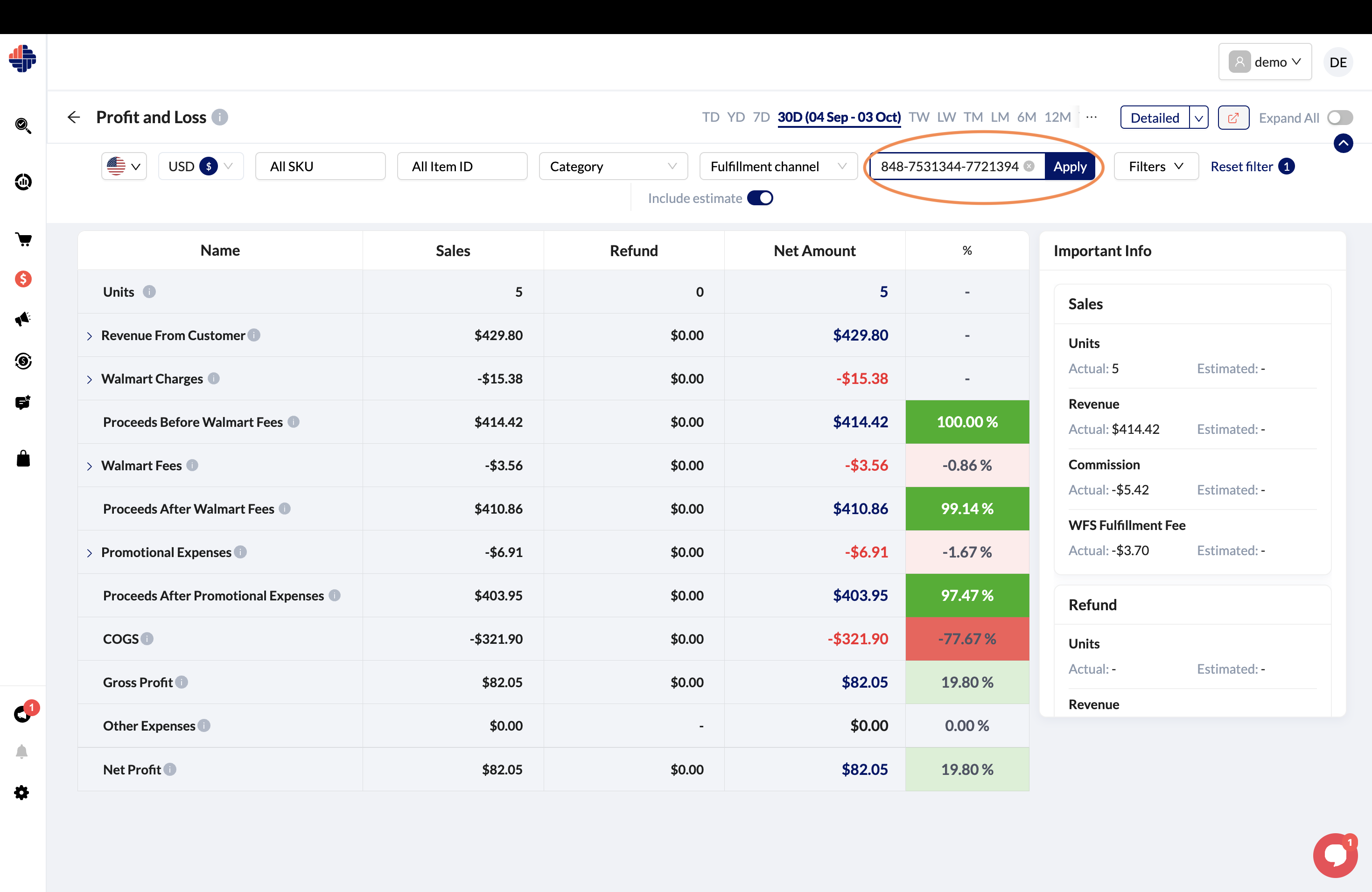
Order Level P & L
The Order Level P&L breaks down profitability by individual orders, providing a granular view of how specific transactions contribute to overall profit margins. This view helps track how fees, shipping, taxes, and other order-related costs impact your profitability on an order-by-order basis.
Sellers can see the exact profit or loss generated by each order, helping them identify high-value orders and patterns that lead to profitable transactions. By tracking costs such as shipping fees, WFS charges, and item taxes at the order level, sellers can identify specific inefficiencies (e.g., shipping methods, refund costs) and optimize accordingly.
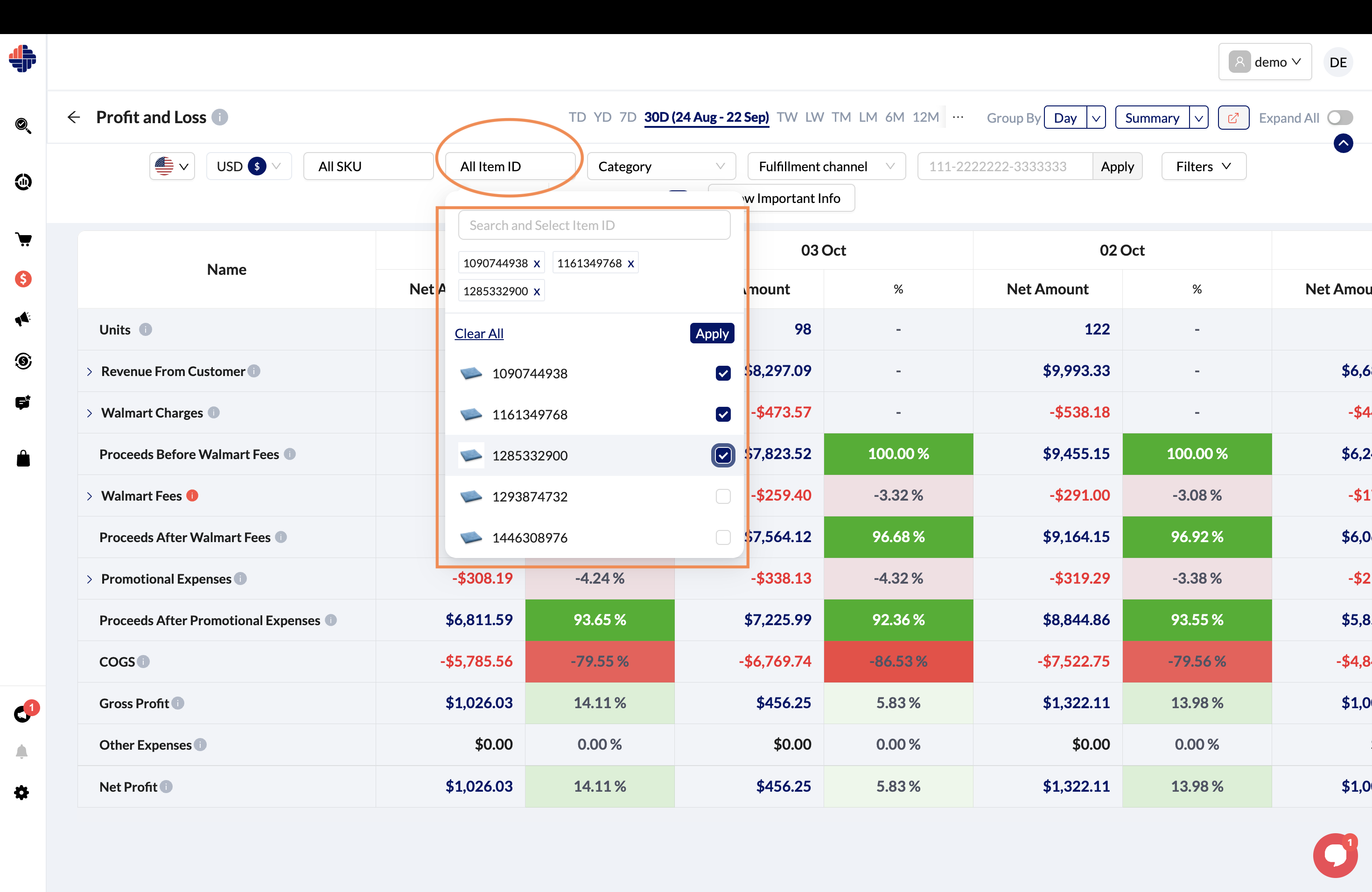
Product Level / Multiple Products Level P & L
The Product Level P&L allows sellers to analyze the profit and loss for individual products or a group of products. This is invaluable for understanding how each item or bundle is contributing to the store’s profitability.
Sellers can see how specific items are performing, factoring in all costs (e.g., commissions, fulfillment, taxes). It helps in understanding the margins for each product and deciding which products to push or adjust.
Grouping Flexibility: Sellers can track profitability for multiple products together (e.g., seasonal items, promotions, or bundles), allowing them to see how certain product lines contribute to overall profits. This view is critical for optimizing product performance, allowing sellers to focus on promoting high-margin items while addressing underperforming products.
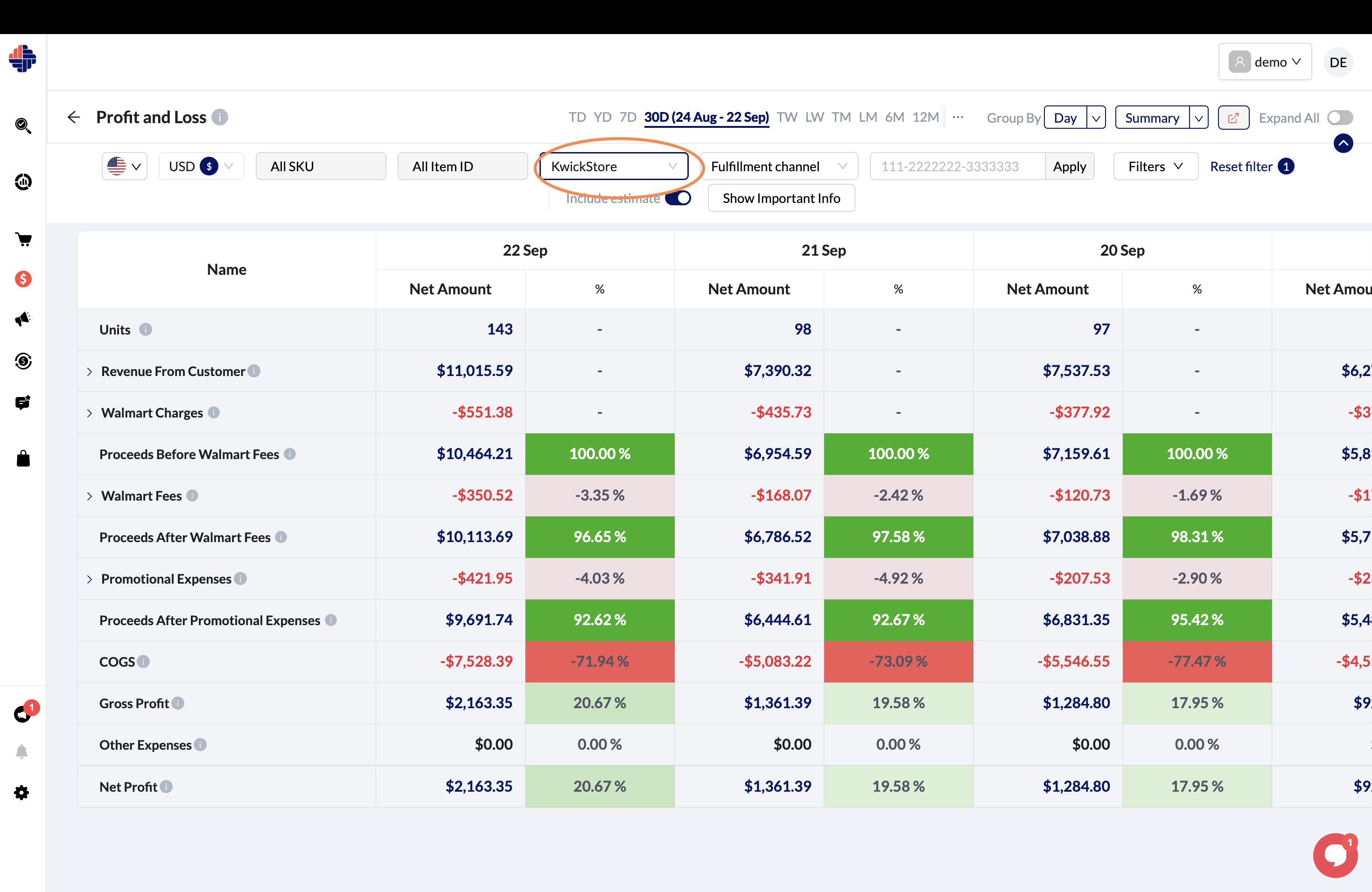
Category Level P & L(Custom Grouping)
The Category Level P&L enables sellers to track the profitability of entire product categories or custom groupings. You can organize products into categories that make sense for your business (e.g., product types, seasonal offerings, or promotions) and assess their financial performance.
Grouping products into categories helps sellers understand which product lines or groups contribute most to overall profitability, making it easier to decide where to allocate resources.
By viewing profitability at the category level, sellers can focus their marketing and inventory efforts on the most profitable product segments, optimizing their business on a broader scale.
Grouping Flexibility: Custom groupings provide flexibility for sellers to analyze profitability across unique categories, such as bundled items or limited-time promotions, and fine-tune strategies for each group.
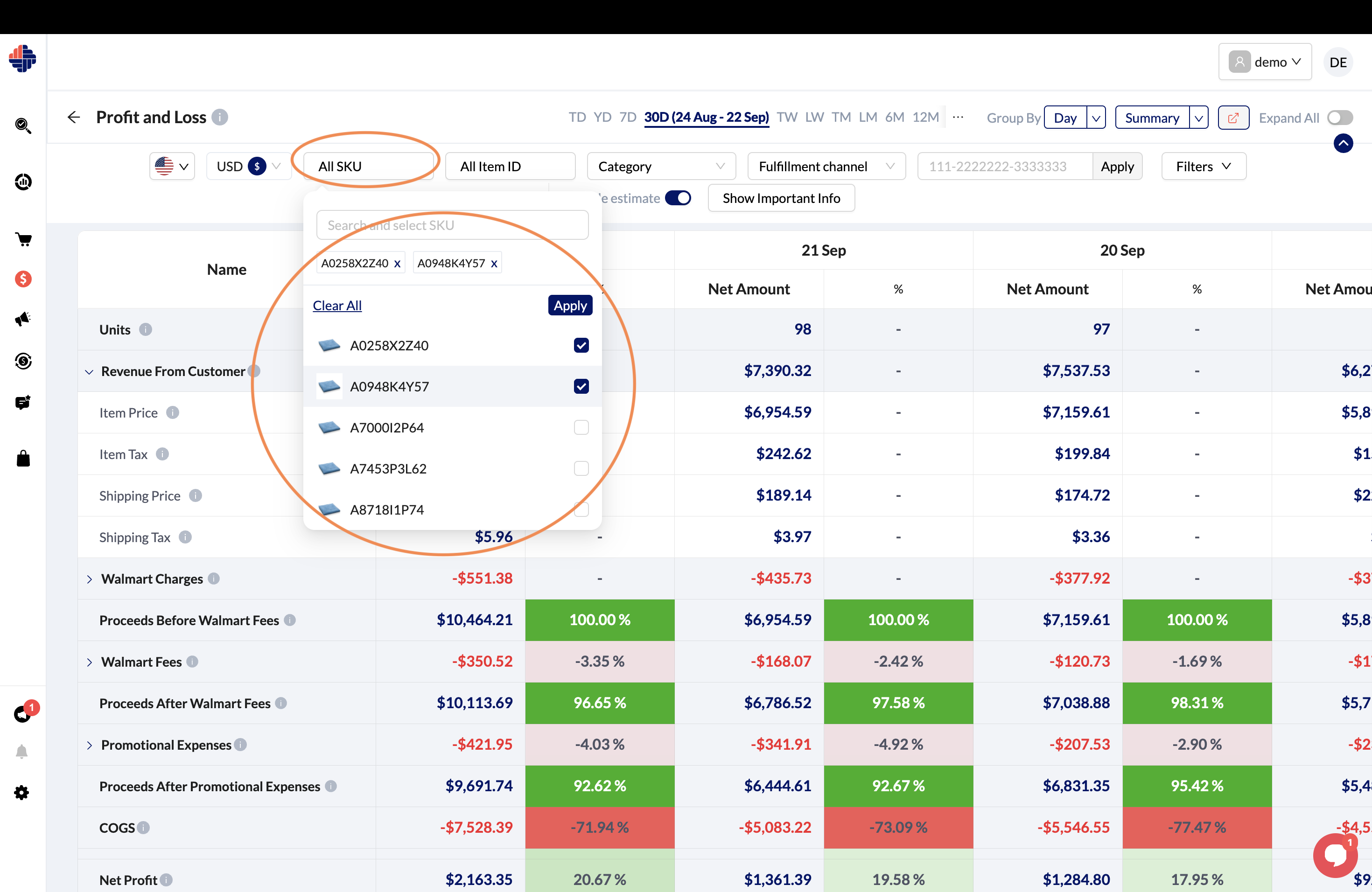
SKU Level P & L
The SKU Level P&L provides an extremely granular view, tracking profitability down to the individual SKU (Stock Keeping Unit). This helps sellers understand how each specific item (within variants, bundles, or multiple fulfillment methods) is performing financially.
Sellers can analyze the profitability of each SKU, factoring in specific costs such as fulfillment, commissions, and item-specific taxes. It allows for pinpoint accuracy in identifying the best- and worst-performing SKUs. With SKU-level data, sellers can make more precise decisions about pricing, promotions, or discontinuing certain variants that don’t meet profitability thresholds. The SKU-level view ensures that every individual product variant is contributing positively to your bottom line, helping you optimize pricing strategies and adjust inventory for maximum profitability.
The P&L reports are available in both Summary View and Detailed View, offering flexibility in how you want to analyze your data, depending on your needs.
Summary View: The summary view provides a high-level snapshot of all charges, fees, and expenses for the selected time period. These are aggregated into single values, offering a quick and clear overview of your profitability. It’s perfect for sellers who want to assess overall performance at a glance.
Detailed View: In the detailed view, all charges, fees, and expenses are broken down in a more granular format. You can view these costs separately for each day, week, or month within the selected time period, giving you a detailed understanding of how each cost impacts your business over time. This view allows sellers to dive deep into their finances, helping them pinpoint where optimizations can be made.
Each type of P&L view—whether at the account, order, product, category, or SKU level—can be accessed through both summary and detailed formats, enabling you to switch between broader and more in-depth reports based on your requirements.
3. Advanced Sales Analytics:
KwickMetrics differs by offering sales analytics not just for Amazon, but also for Walmart sellers, making it a more versatile tool. For Walmart sellers, KwickMetrics provides detailed insights into sales trends, product performance, and market demand, all in one dashboard.
Whether you’re tracking overall sales trends, monitoring individual orders, or analyzing buyer behavior, KwickMetrics delivers the critical data you need to make informed decisions. This comprehensive sales analytics solution empowers sellers to make data-driven decisions. By understanding which products are performing well, sellers can focus on profitable items, and plan better marketing strategies. Additionally, the ability to spot underperforming products or emerging trends allows businesses to quickly adapt and avoid potential losses.
The sales analytics tools allow you to track key metrics such as sales overview, sales trends, top-selling products, and peak sales periods, buyer insights, custom reports, category wise reports, return reports and expenses report and more, all while offering flexible grouping and sorting options for customizable reports. The Sales Order Report is the cornerstone of this analytics suite, offering detailed insights into the sales behaviour for the marketplace. With its powerful reporting features and customization capabilities, the Sales Order Report helps Walmart sellers stay on top of their business performance.
Here’s some of the sample reports from our demo account:

Sales Overview
The Sales Order Report provides a detailed view of your store’s sales, offering both summary and granular insights into your orders. It captures critical data such as:
- Total Orders
- Units Sold
- Revenue
- Estimated Net Profit
- Created Orders (orders that have been placed but not yet processed)
- Acknowledged Orders (orders confirmed by the seller)
- Shipped Orders (orders that have been dispatched)
- Delivered Orders (orders successfully delivered to customers)
This comprehensive overview ensures that Walmart sellers have full visibility into their sales performance and order fulfillment process.
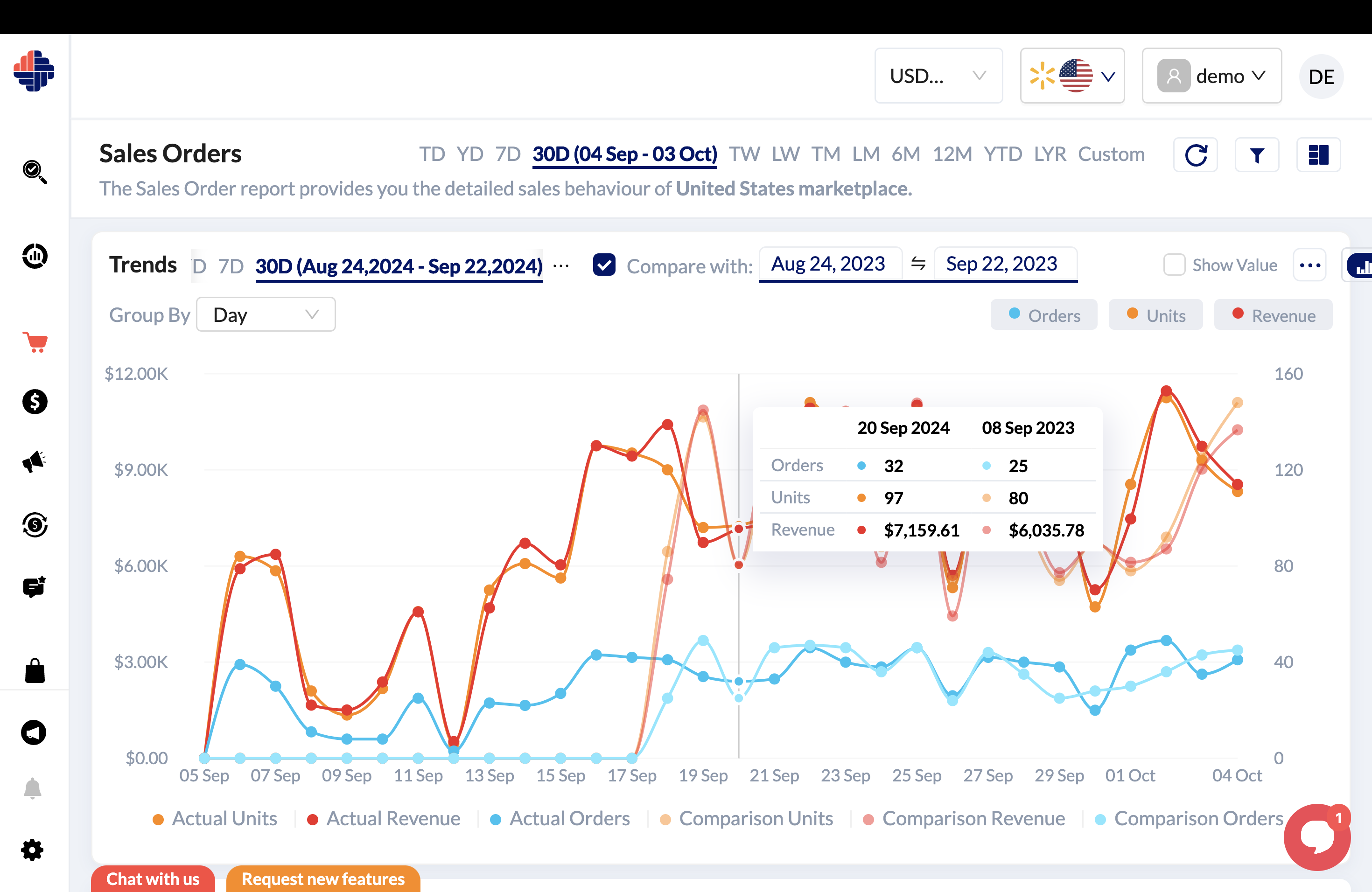
Sales Trends
Trends helps you visualize sales patterns over time, comparing your current sales performance with the same period from the previous year. By identifying these trends, sellers can adjust their strategies to capitalize on growth opportunities or address any downward patterns early on. For instance, if a certain category shows a consistent upward trend, sellers can invest more in that product line, increase inventory, or focus marketing efforts to capitalize on growing demand. It also helps in identifying seasonal shifts or market changes, allowing sellers to be more proactive.

Product Level / Multiple Products Level P & L
The Product Level P&L allows sellers to analyze the profit and loss for individual products or a group of products. This is invaluable for understanding how each item or bundle is contributing to the store’s profitability.
Sellers can see how specific items are performing, factoring in all costs (e.g., commissions, fulfillment, taxes). It helps in understanding the margins for each product and deciding which products to push or adjust.
Grouping Flexibility: Sellers can track profitability for multiple products together (e.g., seasonal items, promotions, or bundles), allowing them to see how certain product lines contribute to overall profits. This view is critical for optimizing product performance, allowing sellers to focus on promoting high-margin items while addressing underperforming products.

Category Level P & L(Custom Grouping)
The Category Level P&L enables sellers to track the profitability of entire product categories or custom groupings. You can organize products into categories that make sense for your business (e.g., product types, seasonal offerings, or promotions) and assess their financial performance.
Grouping products into categories helps sellers understand which product lines or groups contribute most to overall profitability, making it easier to decide where to allocate resources.
By viewing profitability at the category level, sellers can focus their marketing and inventory efforts on the most profitable product segments, optimizing their business on a broader scale.
Grouping Flexibility: Custom groupings provide flexibility for sellers to analyze profitability across unique categories, such as bundled items or limited-time promotions, and fine-tune strategies for each group.
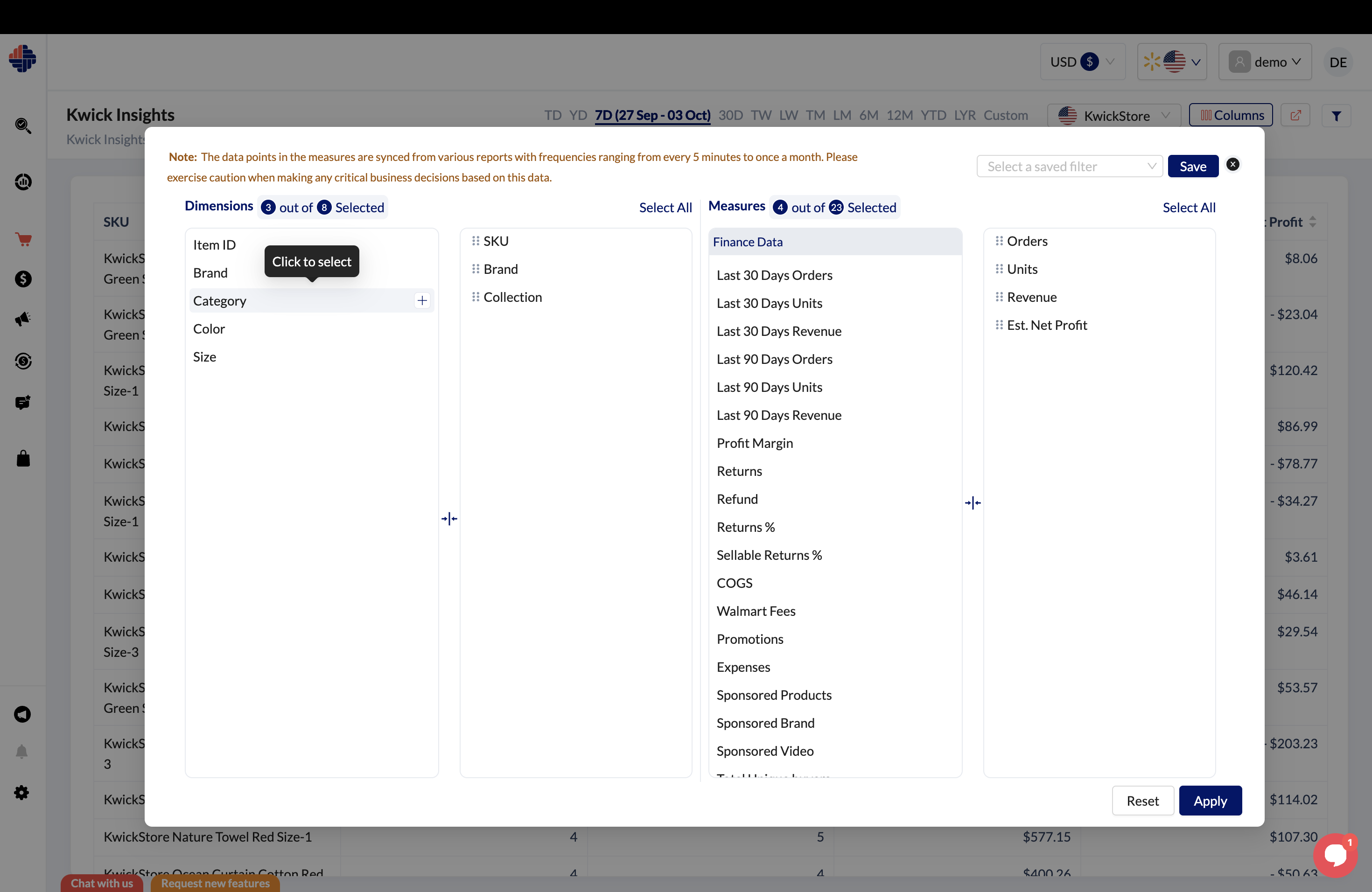
Kwicksights
KwickMetrics also offers a unique feature called Kwicksights, which allows sellers to create fully customized reports. In Kwicksights, sellers can adjust rows and columns to generate tailored reports that meet their specific needs. This flexibility empowers sellers to play around with different data points, allowing for a variety of report views based on individual business requirements.

Buyer wise Insights
The Buyer-Wise Insights feature in KwickMetrics provides Walmart sellers with valuable data on individual customers, enabling them to understand buyer behavior, purchasing patterns, and preferences. This report helps sellers identify their most loyal customers, segment buyers based on their purchasing habits, and tailor their marketing and product strategies to maximize customer engagement and revenue.
Buyer Trends and Patterns:
Track buyer behavior over time to identify trends, such as the frequency of purchases, preferred product categories, or specific times of year when certain buyers are more active. This insight enables sellers to plan personalized marketing campaigns based on these patterns.
Top Buyers:
The report highlights your top buyers, providing you with insights on who your most loyal and highest-spending customers are. By nurturing these relationships through loyalty programs, exclusive offers, or personalized discounts, you can further boost customer retention and sales.
Geographic and Demographic Data:
The Buyer-Wise Insights report can also offer geographic and demographic insights, showing where your customers are located and helping you identify key regions or buyer groups to target with localized promotions.
By having detailed information on buyer preferences, sellers can improve the overall customer experience. Offering personalized recommendations, addressing specific customer needs, and creating targeted offers based on previous purchases enhance customer satisfaction and loyalty.
Together, these metrics enable sellers to create strategic plans, manage resources effectively, and ultimately boost profitability by acting on data rather than guesswork.
KwickMetrics, by covering Sales Analytics for both platforms, offers sellers a unified tool for maximizing their business potential without switching between multiple services while Sellerboard is primarily focused on Amazon and other e-commerce platforms, limiting its scope for Walmart sellers. This makes it a stronger fit for sellers aiming to grow on Walmart and Amazon simultaneously.
4. Advanced Ads Analytics:
KwickMetrics offers detailed ad campaign performance tracking for both Walmart and Amazon sellers. Sellers can monitor the effectiveness of their ad campaigns in real-time, evaluating metrics such as impressions, clicks, conversion rates, and return on ad spend (ROAS). This helps identify which campaigns are performing well and where improvements are needed.
This tracking allows sellers to optimize their advertising budget, focusing on campaigns that drive sales and cutting those that don’t. By continually refining their ad strategies, sellers can increase visibility, improve ROI, and enhance overall profitability.
In contrast, Sellerboard primarily focuses on Amazon ad tracking, limiting insights for other ecommerce platforms. KwickMetrics provides a more comprehensive solution, making it ideal for those selling across multiple platforms.
5. Reimbursement Management:
KwickMetrics makes it easy for sellers to track and recover eligible reimbursements from both Walmart and Amazon. It automatically identifies missed or incorrect charges, ensuring you claim refunds you’re entitled to. The tool simplifies the process by automating reimbursement tracking and claims submission, so sellers never miss out on potential refunds. KwickMetrics offers a account audit at free of cost for all Walmart sellers to identify eligible reimbursements. Click here to initiate your free account audit.
Additionally, KwickMetrics offers a service where its team handles filing and managing claims on a commission basis, making the entire recovery process seamless and efficient. Unlike Sellerboard, which focuses only on Amazon Reimbursement for lost and damaged goods, KwickMetrics supports both platforms covering almost 98% of scenarios, offering a more comprehensive solution for sellers.
Complete details on possible Reimbursements can be observed from the following sections.
- Dashboard: Displays all eligible reimbursements along with their claim windows and eligible amounts.
- Case Tracker: Provides complete details on the status of each case, ensuring transparency and easy monitoring.
- Documents: Contains the settlement reports for all resolved claims, providing a comprehensive record for reference and analysis.
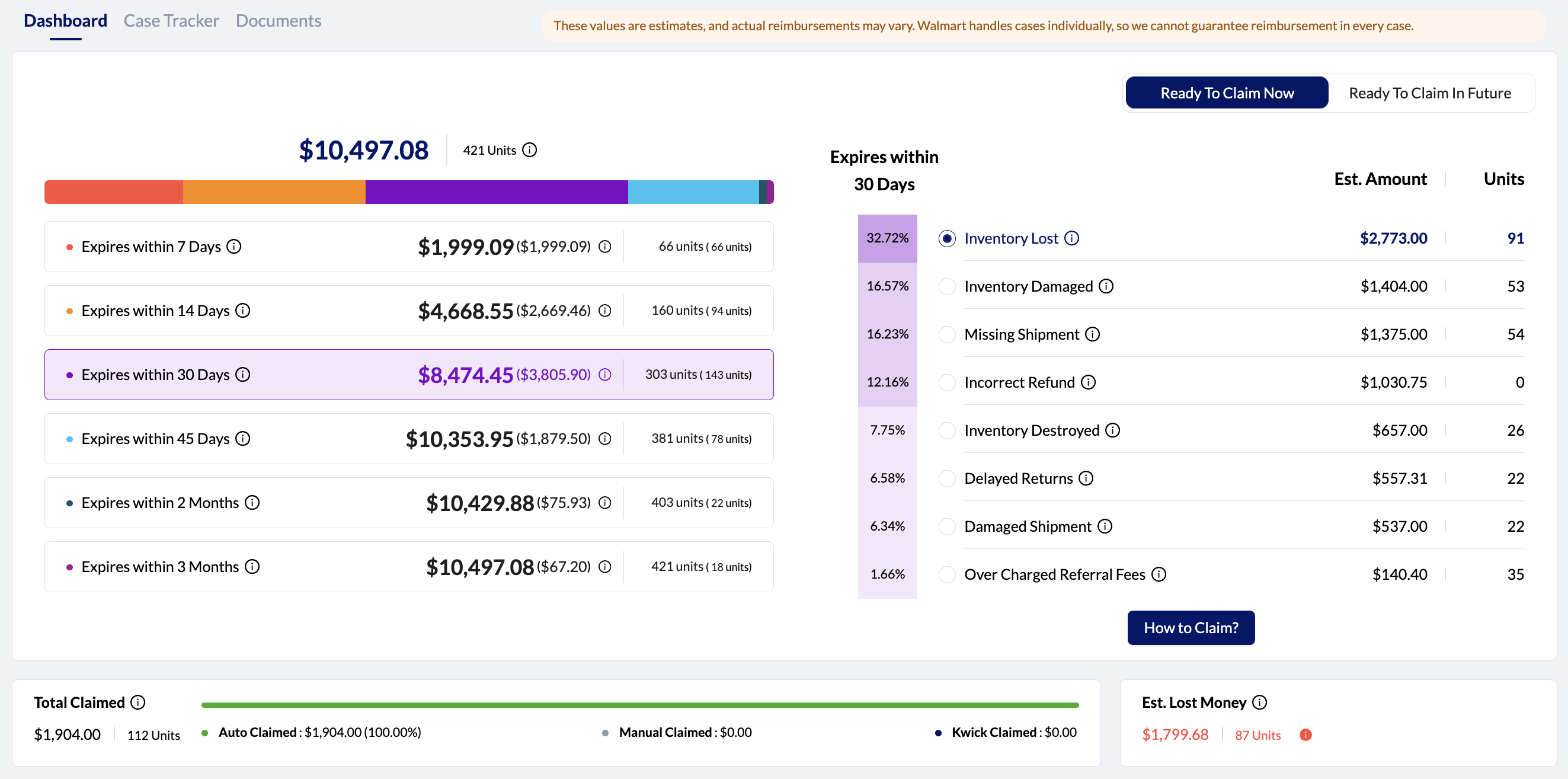
Reimbursement Dashboard
The Dashboard in KwickMetrics provides a centralized view of all eligible reimbursements for Walmart sellers. It is designed to help sellers stay on top of their potential refunds and ensures that no reimbursement opportunity is missed. Here’s what you’ll find on the dashboard:
-
Claim Window Each reimbursement entry comes with a time-sensitive claim window, indicating the deadline for filing the claim to ensure eligibility.
-
Eligible Reimbursement The dashboard displays the total eligible amount for each reimbursement opportunity, helping sellers understand the financial impact of missed or incorrect charges.
-
Summary Overview Sellers can quickly see an aggregated summary of all eligible claims, providing clarity on potential recoverable amounts at a glance.
-
Proactive Notifications / Alerts Alerts or reminders are displayed to highlight claims approaching their expiration date, ensuring timely action.
This section gives sellers a high-level view of all claims, making it easy to manage their reimbursement process effectively and avoid missed deadlines.
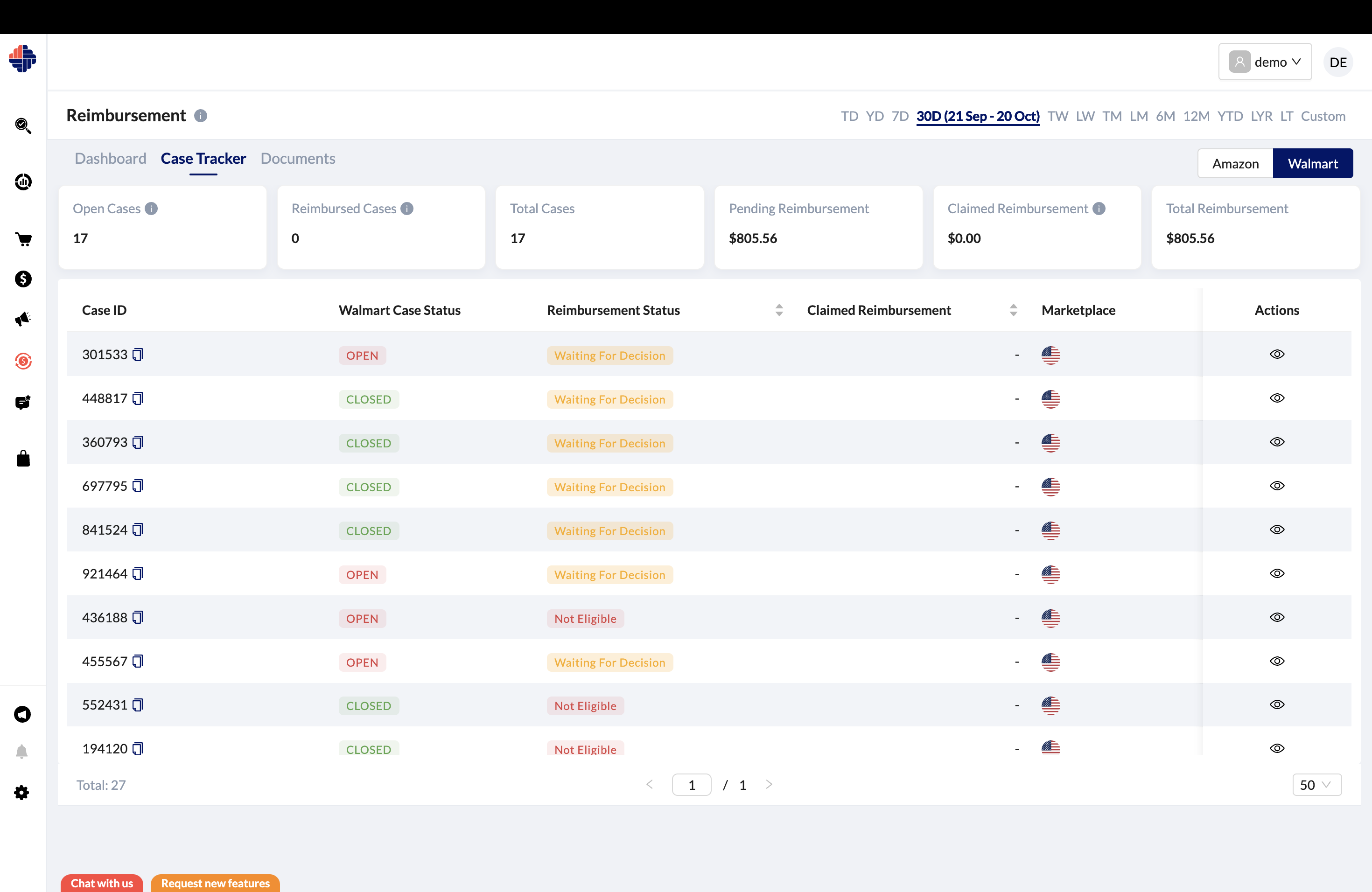
Case Tracker
The Case Tracker offers detailed insights into the status of each individual case, allowing sellers to monitor every step of their reimbursement journey. This feature ensures transparency by keeping sellers updated on the progress of their claims. The following details can be observed from Case Tracker:
- Case Id
- Case Status
- Reimbursement Status
- Complete case details such as Claimed Units, Claimed amount, Order Id, SKU, Estimated pending quantity and amount of the particular case ID.

Settlement Reports
View detailed reports on all resolved claims, including amounts refunded, settlement dates, and payment references. Sellers can export or download settlement reports for offline record-keeping, audits, or financial reviews. The Documents Tab maintains a well-organized record of all cases, making it easy to retrieve specific settlement reports when needed. Use the settlement reports for account reconciliation, ensuring that all eligible reimbursements have been processed and received correctly. This section offers sellers a structured way to track financial settlements and maintain complete transparency over their reimbursement history, aiding in accounting and audits.
6. Review and Feedback Automation:
KwickMetrics streamlines the process of automating review requests and managing feedback for both Amazon and Walmart sellers. By automating this task, sellers can boost customer engagement and significantly increase review counts. KwickMetrics allows you to fully customize the content of your feedback request emails, tailoring them to fit your brand’s voice. You can also schedule these requests based on your preferences, ensuring the timing aligns with when customers are most likely to leave reviews.
Additionally, KwickMetrics enables sellers to set different time periods for various products, helping to gather more genuine and insightful reviews. The platform also tracks customer feedback, allowing sellers to monitor and address negative reviews quickly. This automation not only improves review quality and quantity but also strengthens customer relationships and brand reputation.
Benefits of Choosing KwickMetrics as your Tool for Walmart Business
1. Customization and Scalability:
Whether a small or large business, KwickMetrics scales with the growth of your Amazon and Walmart store. KwickMetrics offers flexible customization options to tailor reports, dashboards, and features to your unique business needs. As your business grows, our scalable platform adapts effortlessly. Customized solutions at customized pricing is also available for large businessess and agencies.
2. User Experience and Interface:
KwickMetrics delivers a seamless and user-friendly experience, with a clean, intuitive dashboard designed to simplify data navigation. Users can easily access detailed analytics and insights with minimal effort, thanks to a streamlined interface that prioritizes ease of use. Compared to Sellerboard, KwickMetrics offers more metrics in a more efficient workflow, allowing you to dive into essential metrics quickly and effectively, helping you make informed decisions without the hassle of complicated navigation.
3. Support and Customer Service:
Highlight the quality of customer service and support provided by KwickMetrics, including onboarding assistance, resources, and personalized support, which could give it an edge over Sellerboard.
4. Innovative Features:
Emphasize any unique or upcoming features in KwickMetrics that Sellerboard may not offer, such as enhanced automation, predictive analytics, or advanced reporting capabilities.
Limitations of KwickMetrics
While KwickMetrics offers a powerful suite of tools for e-commerce sellers, like any platform, it has certain limitations that users should be aware of. These limitations typically arise from the platform’s focus on specific features or ongoing development efforts. Understanding these areas can help sellers make informed decisions, especially if they require capabilities that extend beyond what KwickMetrics currently offers. Here are some of the key limitations:
Limited Walmart Marketplace Support
KwickMetrics currently supports only Walmart.com alongside all Amazon marketplaces. Sellers who operate on international Walmart marketplaces will find this limitation restrictive, as the platform is still expanding its coverage to include other regions. For sellers expanding into international Walmart marketplaces, KwickMetrics has begun beta testing its features. While this functionality is in beta stage, it allows early access to multi-region support with ongoing improvements and updates. As the platform evolves, KwickMetrics will roll out complete international Walmart marketplace support, making it a future-proof solution for global sellers.
Making the Right Choice for Your Walmart Success
Choosing the right tools for your e-commerce business is crucial for maximizing efficiency and profitability. While Sellerboard offers solid analytics and basic reimbursement tracking for Amazon sellers, it falls short in several key areas, including support for Walmart platform, advanced customization, and a broader range of features.
KwickMetrics, however, stands as a good comprehensive solution and one of the best alternative for Sellerboard. With its dual-platform support for both Amazon and Walmart, advanced analytics, and automation capabilities, KwickMetrics addresses the gaps left by Sellerboard. The platform’s ability to handle more complex reimbursement scenarios and its greater customization options make it a superior choice for sellers seeking to optimize their operations across multiple channels.
Moreover, KwickMetrics offers complimentary $200 reimbursement claim and a 20% discount for new users, further enhancing its value proposition. By choosing KwickMetrics, you invest in a tool that not only meets your current needs but also grows with your business, helping you stay ahead in the competitive e-commerce landscape.
Click here to learn more about how KwickMetrics serves as a powerful alternative for Amazon sellers as well.
Experience KwickMetrics in Action—No Account Needed!
No credit card required.


